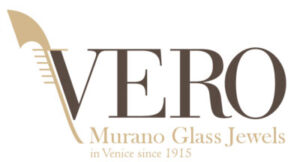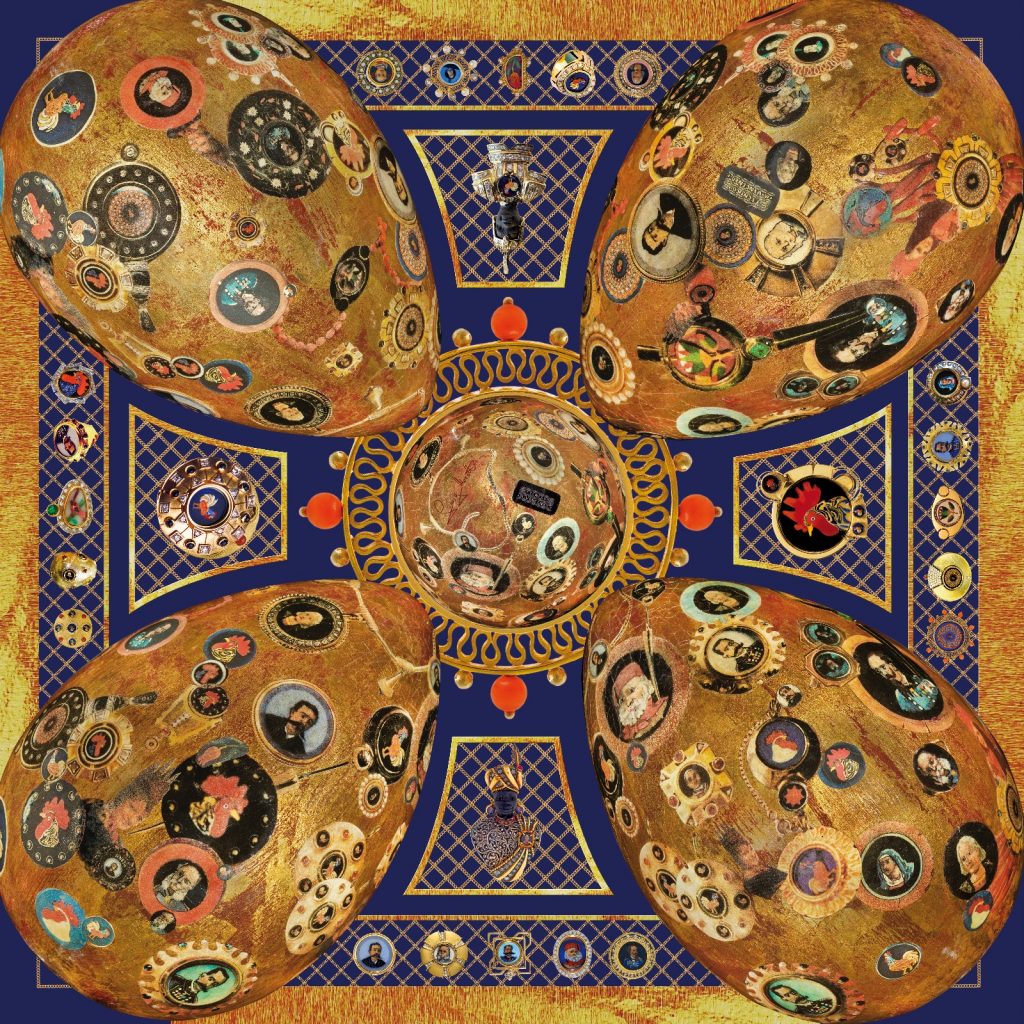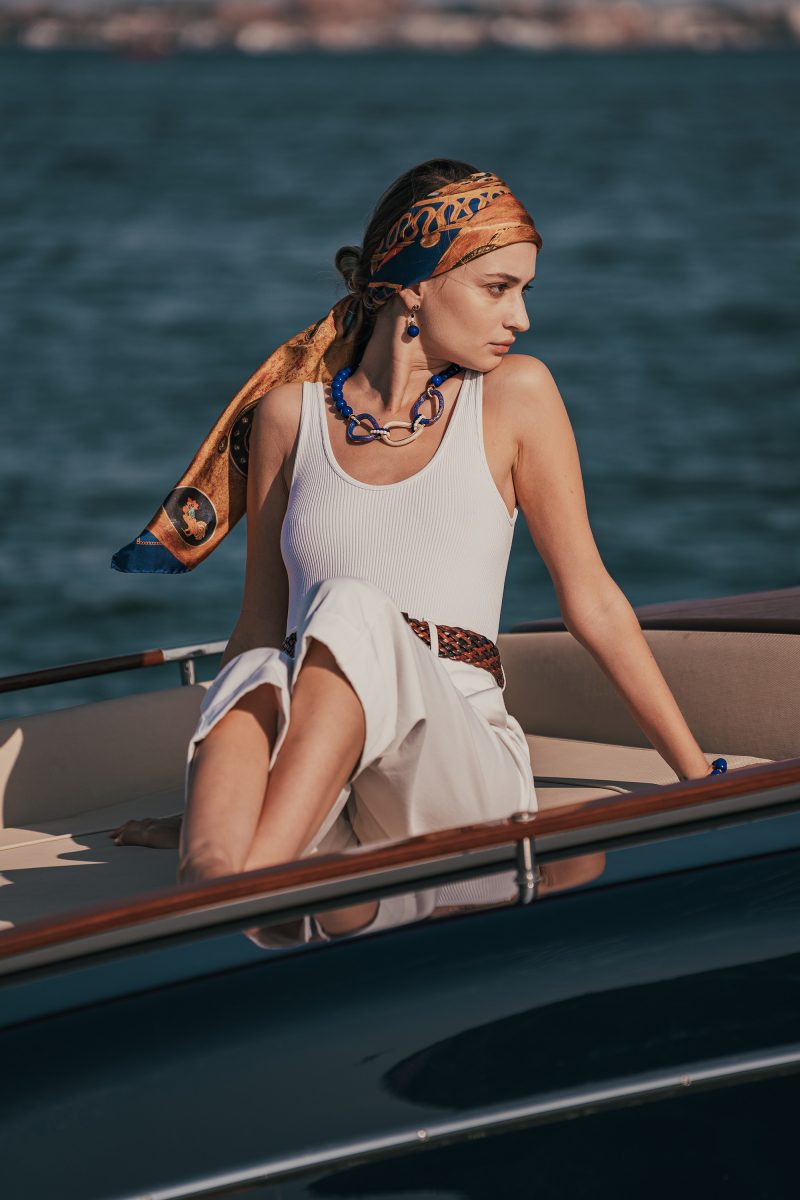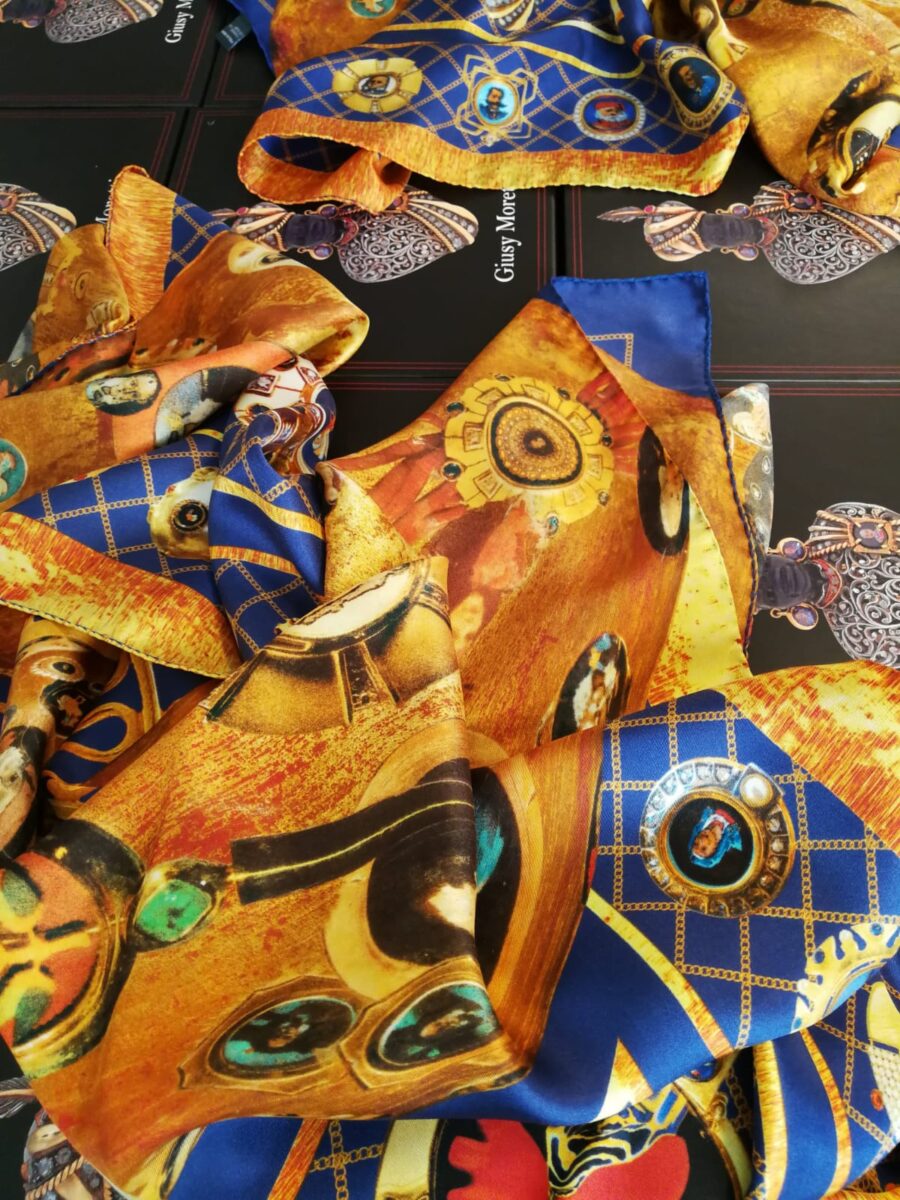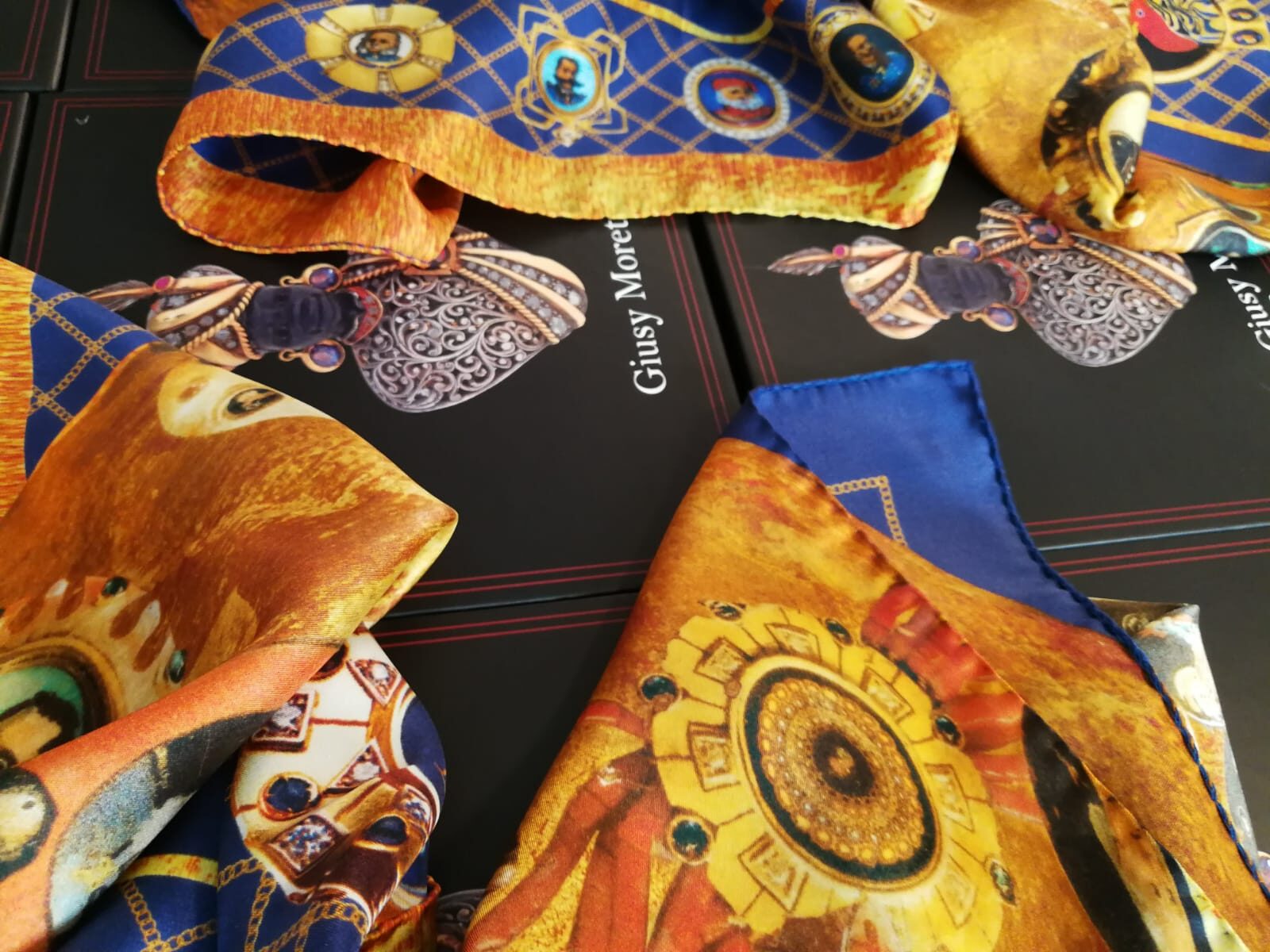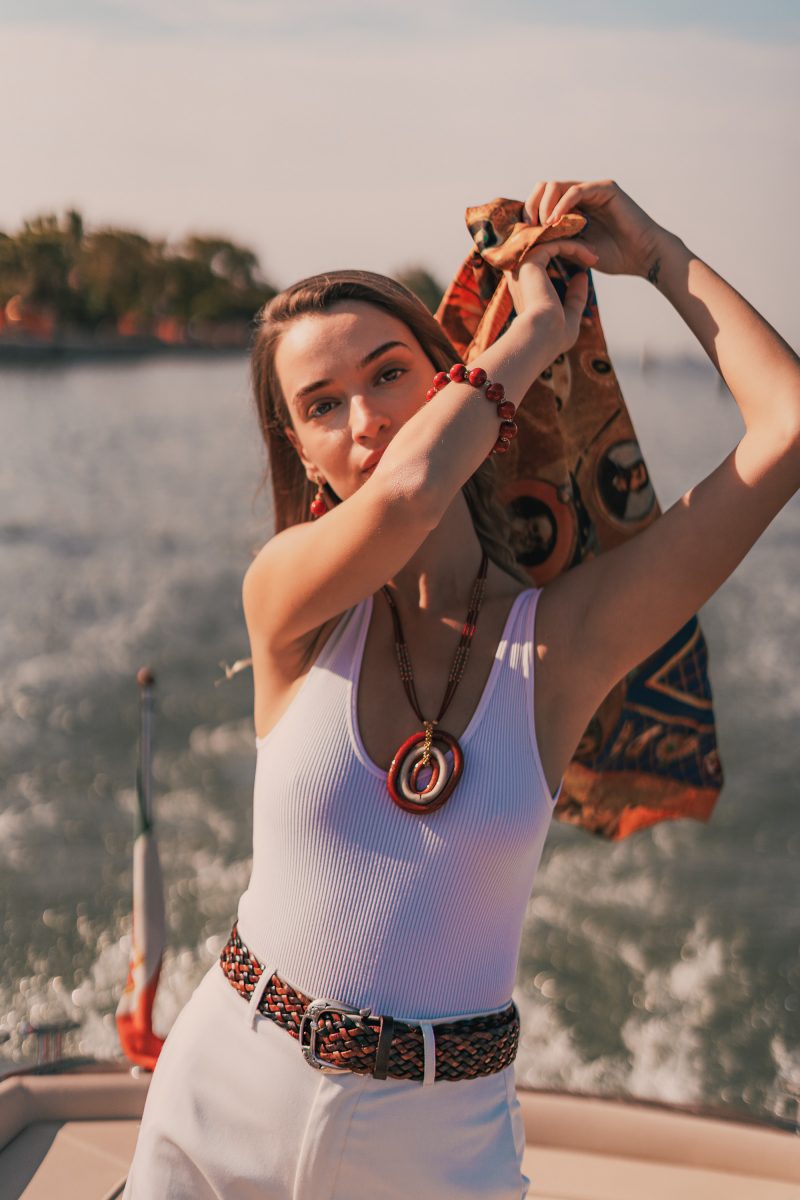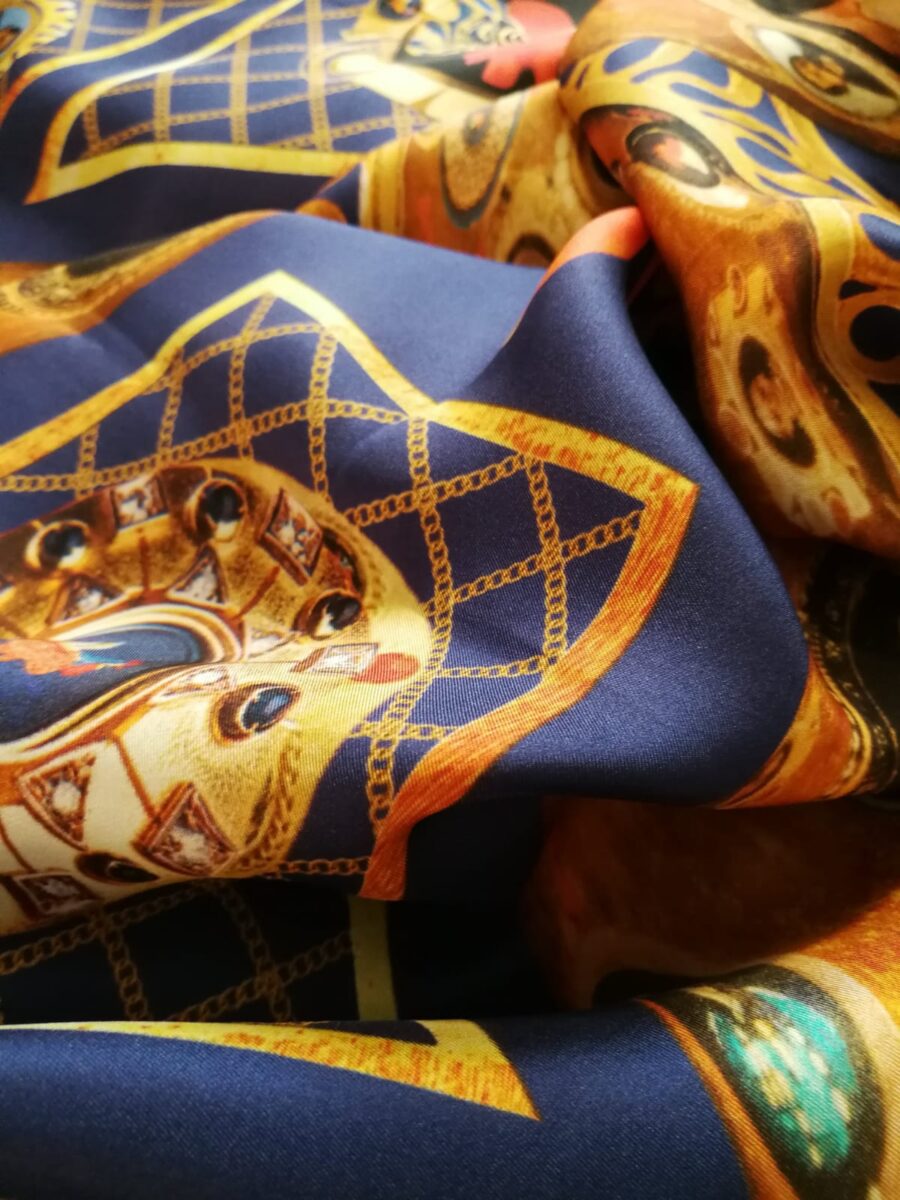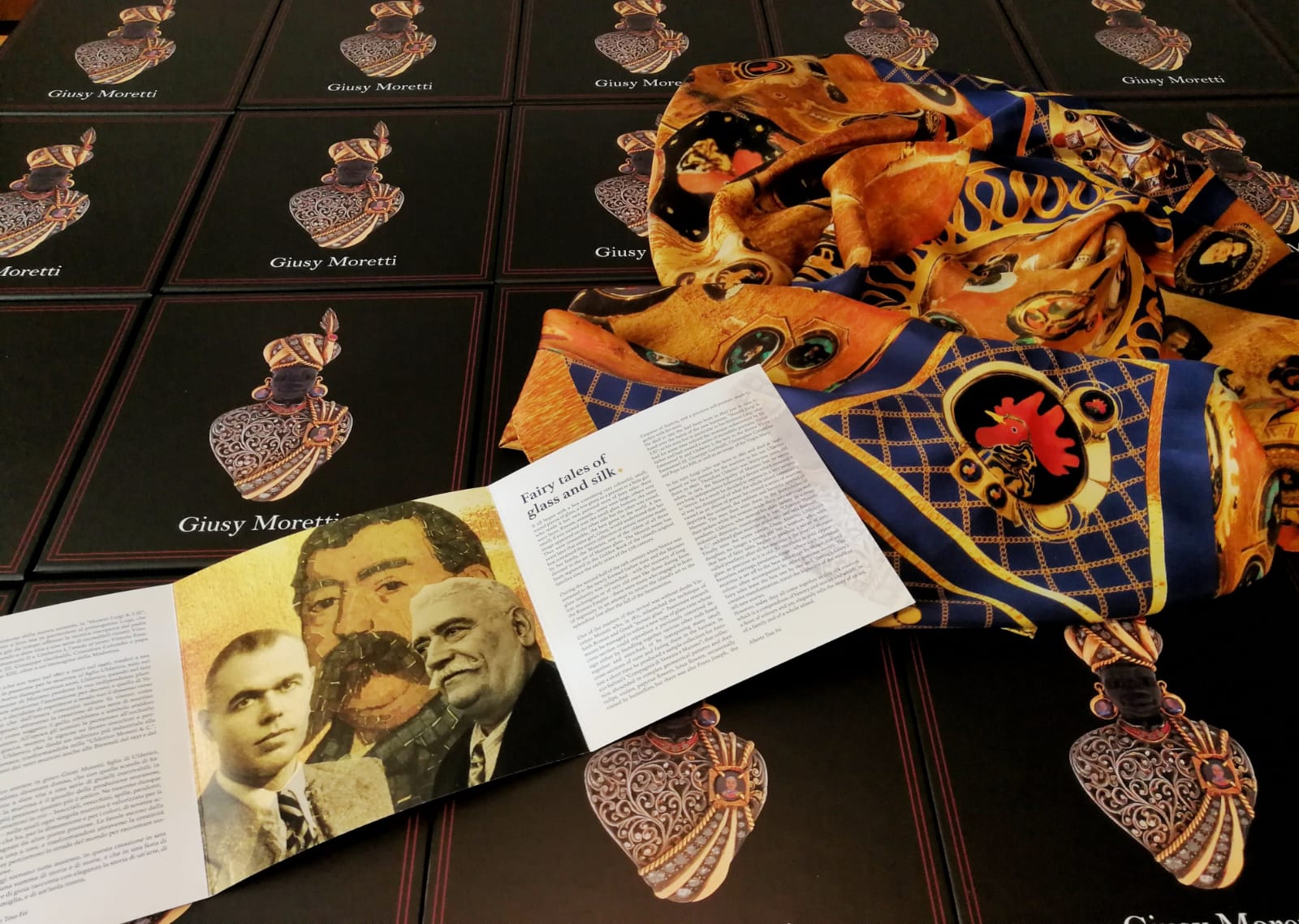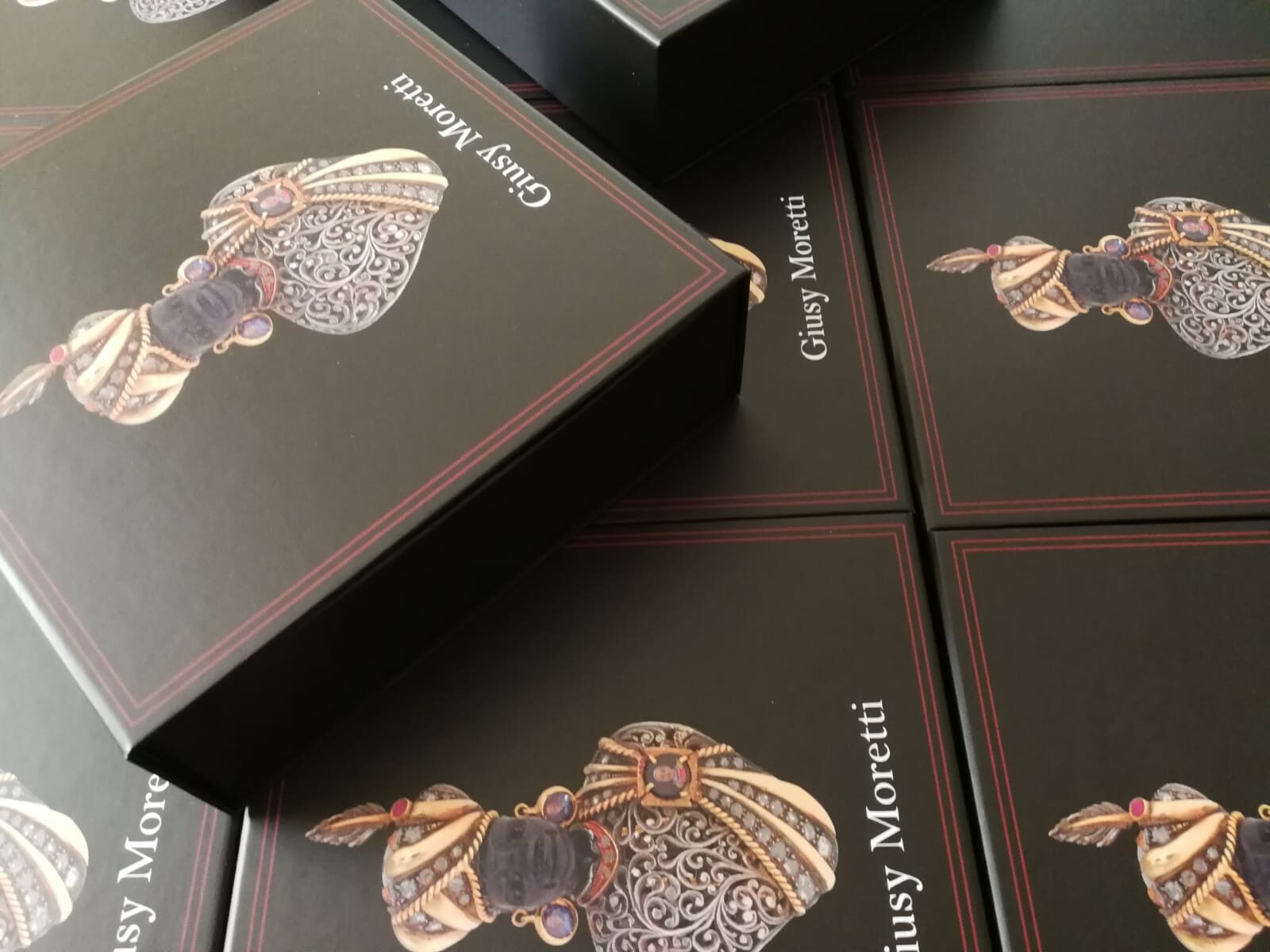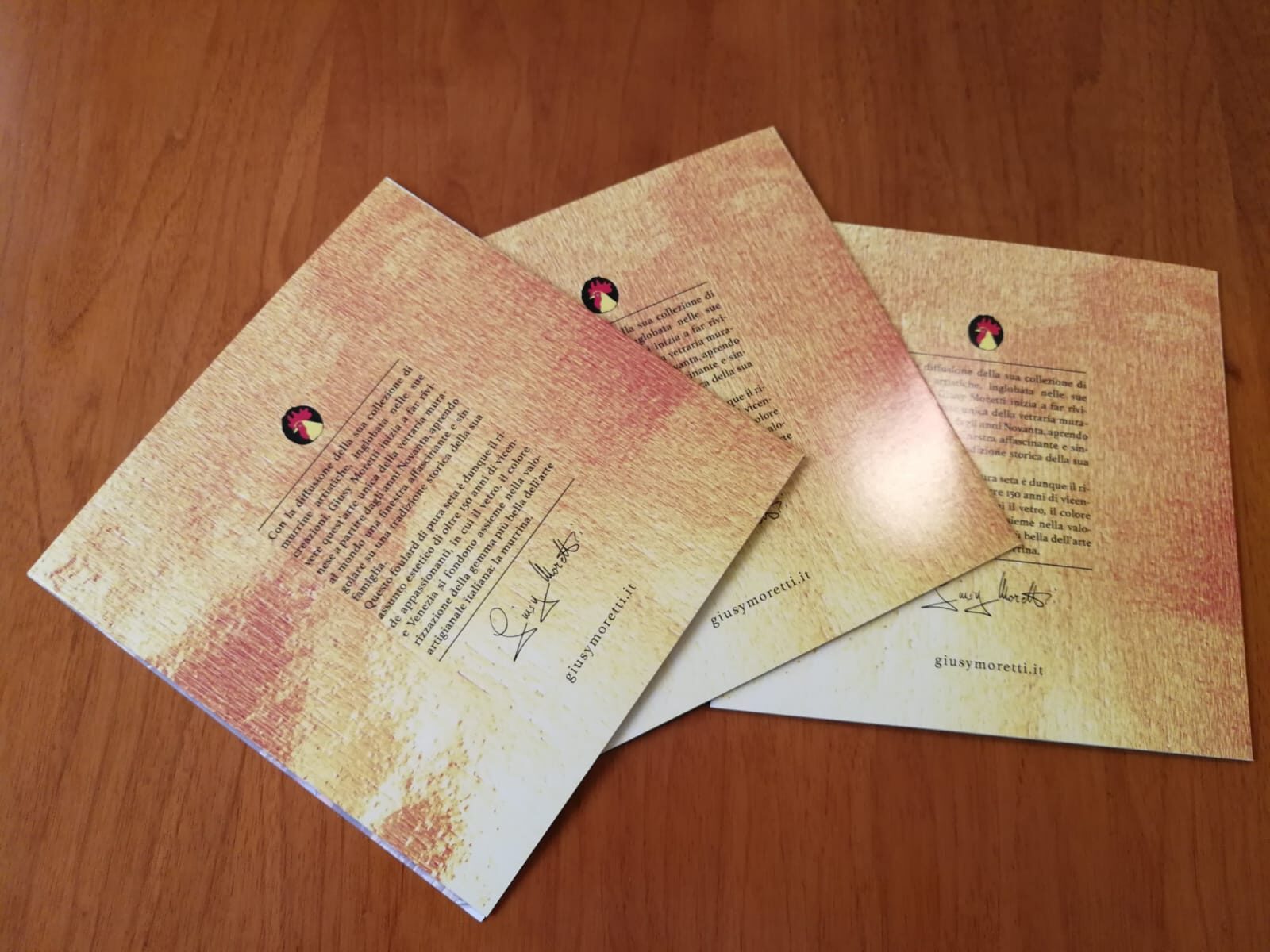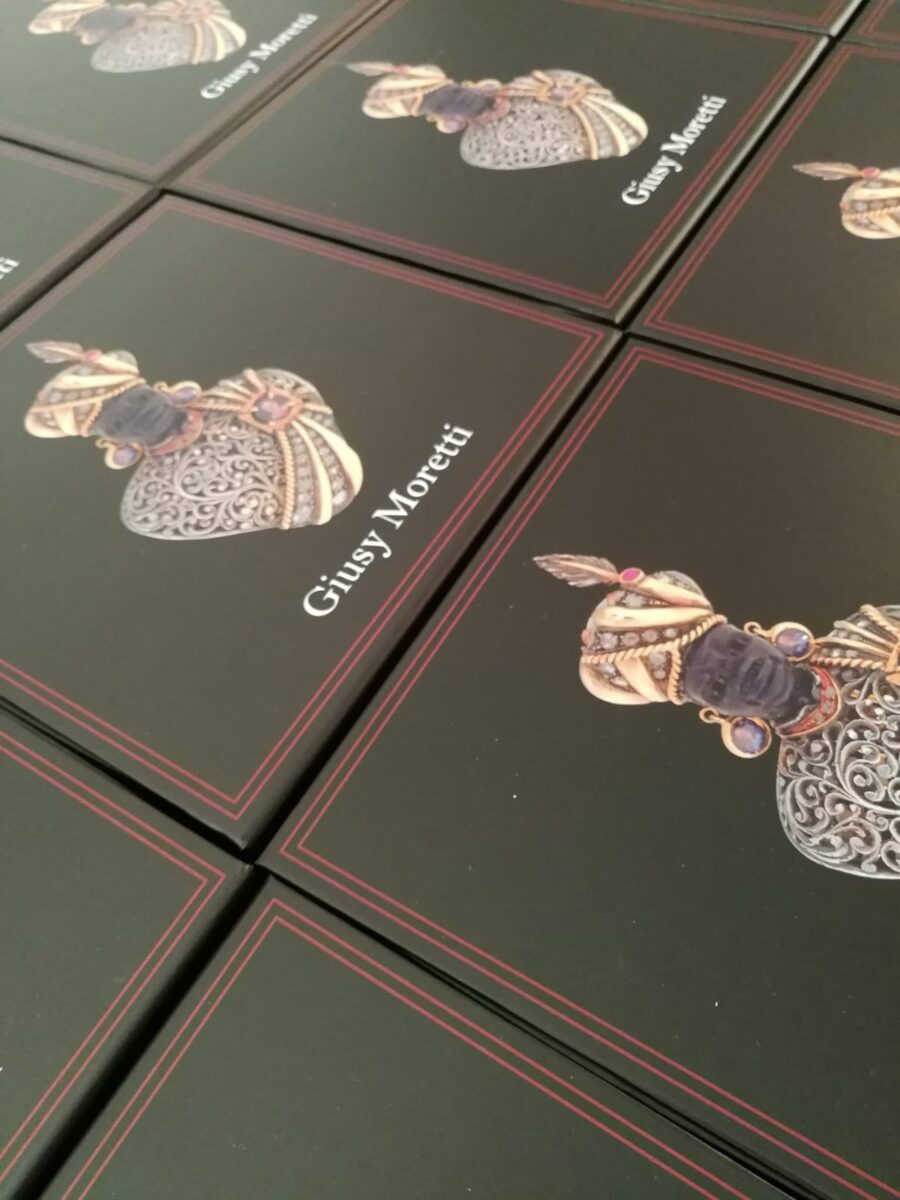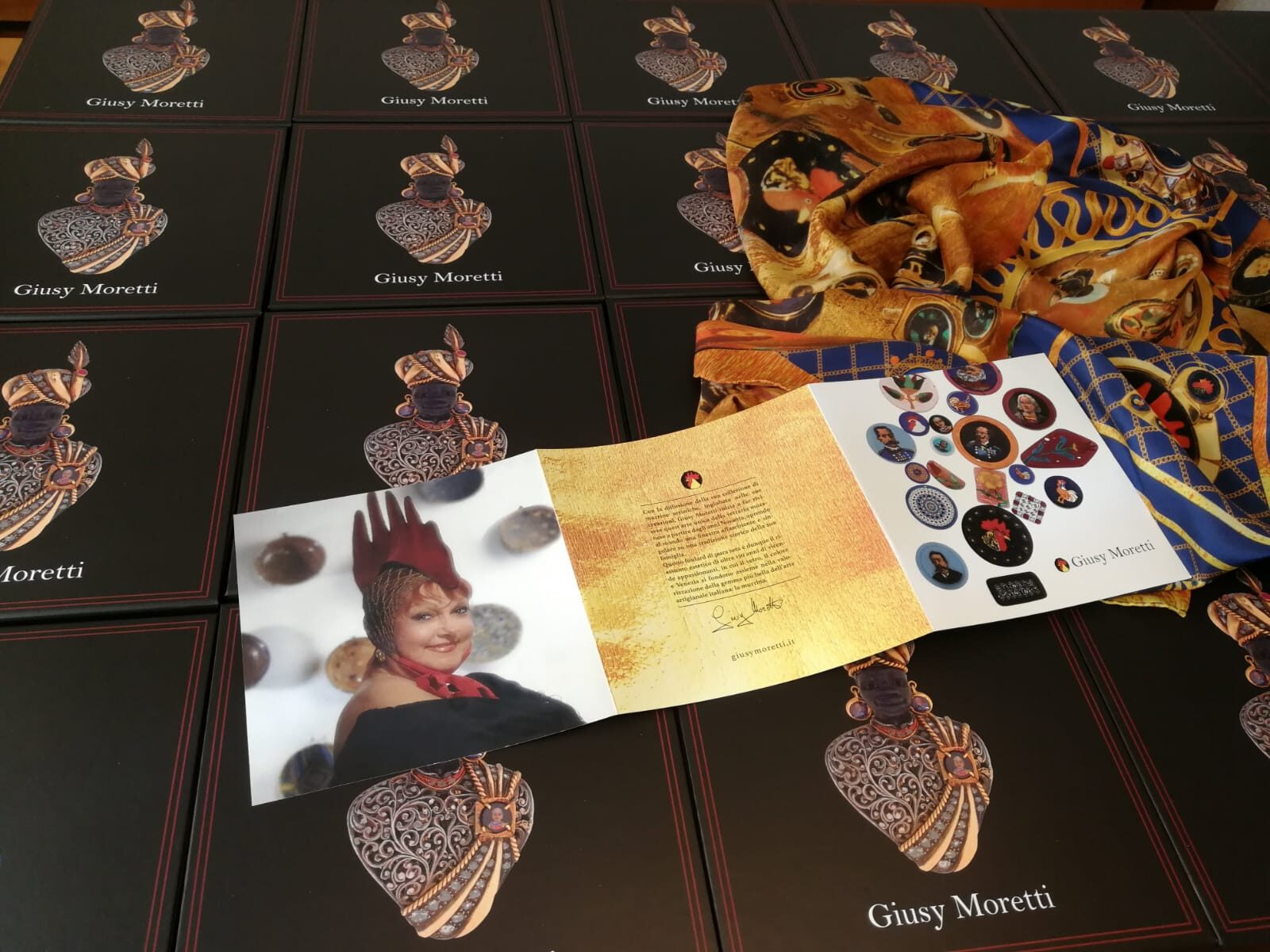Giusy Moretti Luxury Design
L’artista: https://www.giusymoretti.it/artista/
Nella primavera del 2018 viene portato a termine il progetto “Fiabe di Vetro e di Seta®” :
150 anni di storia vengono elegantemente raggruppati in un Foulard in seta pura, pregevolissimo ed unico accessorio non solo di moda ma anche d’arredamento.
Misure: cm 120×120
Presentato in un elegante cofanetto, al cui interno si trova una presentazione dell’opera a cura di Alberto Toso Fei, il Foulard viene proposto nei Bookshop dei più importanti Musei Vetrari e nelle gallerie specializzate.
In the spring of 2018 the “Fairy Tales of Glass & Silk®” project was completed:
150 years of history are elegantly grouped in a pure silk Foulard, very valuable and unique accessory not only in fashion but also in furniture.
Size cm 120×120
Packaged in an elegant box, in which there is a presentation of the work by Alberto Toso Fei, the Foulard will be proposed in the Bookshops of the most important Glass Museum and in the specialized galleries.
“ Fiabe di Vetro e di Seta®”
In principio fu una scatola con dei piccoli vetri tondi molto colorati, regalata a una bambina che ne fece la sua personale riserva di fiabe: c’erano volti, fiori, animali… alcuni grandi, altri piccolissimi; se giravi i bottoncini di vetro compariva la stessa immagine sull’altro lato, però rovesciata.
Erano irresistibili, il miglior gioco del mondo.
Qualche anno più tardi quella bambina, Giusy, realizzerà che in quella scatola vi era l’intera produzione di murrine d’arte della sua famiglia, i Moretti, una delle più antiche tra quelle dedite all’arte vetraria muranese, iscritta nel Libro d’Oro delle famiglie originarie dell’isola fin dai primi anni del Seicento.
Nella seconda metà dell’Ottocento, con l’annessione di Venezia alla neonata nazione italiana e il rilancio dell’industria vetraria muranese – che passò anche attraverso il recupero di tecniche perdute nel tempo oppure antichissime, come quelle derivate dall’impero romano – furono in parecchi a cimentarsi in virtuosismi nell’intento di riportare l’arte isolana ai fasti perduti dopo la caduta della Serenissima.
Uno degli artefici di questo rinnovamento fu sicuramente Vincenzo Moretti che nel 1871 riportò in vita la tecnica del “vetro mosaico”, romano ed ellenistico. Ricercatore appassionato, riuscì a mettere a punto un nuovo tipo di canna vitrea capace di presentare – in sezione – un disegno ideato in precedenza con l’accostamento di varie altre canne fuse assieme e tirate, oppure composto da tante piccole sezioni di canna giustapposte e fuse in fornace. In poco tempo elaborò per la Compagnia di Venezia e “Murano” di Antonio Salviati un campionario ricco di complesse decorazioni geometriche e poi tulipani, violette, papiri, fiori di loto, a volte visitati da farfalle; ma anche l’imperatore d’Austria Francesco Giuseppe e un prezioso autoritratto, realizzato assieme ai figli.
Morì nel 1901 (era nato nel 1835) giusto in tempo per lasciare il testimone della nuova azienda, la “Moretti Luigi & F.lli”, proprio a loro ma in particolare al primogenito Luigi, che aveva già da tempo affinato la tecnica riscoperta dal padre riuscendo a dare vita a una serie di incredibili ritratti: Vittorio Emanuele II e Umberto I, l’erede al trono Vittorio Emanuele III, Giuseppe Garibaldi, Cristoforo Colombo e papa Leone XIII, oltre a un’immagine della Madonna.
Luigi (che era nato nel 1867 e morì nel 1946), trasferì a sua volta la passione per le murrine al figlio Ulderico, nato nel 1892. Aveva dunque trentun anni, Ulderico, quando nel 1923 il Comune di Murano perdette la sua indipendenza plurisecolare attraverso l’annessione per decreto a quello di Venezia, e decidette di esprimere a modo suo il dissenso verso quello che dall’intera comunità isolana fu vissuto come un sopruso attraverso la creazione di una serie di murrine aventi come soggetto il gallo, emblema e simbolo araldico di Murano. All’epoca gli uomini le portarono all’occhiello della giacca, mentre le signorene fecero orecchini e pendenti. Ulderico, che diede un indirizzo più industriale alla sua fornace, trasformandola nella “Ulderico Moretti & C.”, presentò dei vetri murrini anche alle Biennali del 1932 e
del 1934.
Ed ecco entrare in gioco Giusy Moretti, figlia di Ulderico, la bambina diventata donna, che con quella scatola di fiabe inizia a dare vita a una serie di gioielli inarrivabili: in fondo la murrina è il gioiello della produzione muranese, tanto più prezioso quanto più è antico. Ne nascono dunque delle creazioni in oro – bracciali, orecchini, spille, pendenti, anelli – nelle quali ogni singola murrina è valorizzata per la forma che ha, per la dimensione e per i colori, di sovente accompagnati da altre pietre preziose.
Le favole escono dalla scatola una a una, e trasformandosi attraverso la creatività di Giusy percorrono le strade del mondo per raccontare storie nuove.
Ma oggi tornano tutte assieme, in questa creazione in seta che è una summa di storia e di storie, e che in una festa di colori e di gioia racconta con eleganza la storia di un’arte, di una famiglia, e di un’isola intera.
Alberto Toso Fei
“ Fairy
“Fairy Tales of Glass & Silk®”
It all began with a box containing very colourful, small, round pieces of glass, a box given as a present to a little girl who made it her own personal store of fairy tales: there were faces, flowers, animals… some were large, others very small; if you turned over the small glass buttons, the same image appeared on the other side but the other way round.
They were irresistible, the best game in the world.
A few years later that same girl, Giusy, would understand that her box contained the entire collection of artistic murrine made by her family, the Morettis, one of the oldest of all those devoted to the art of Murano glass. The Moretti name has been registered in the Golden Book of the island’s original families since the early years of the 17th century.
During the second half of the 19th century when Venice was annexed to the newly formed Italian state and the Murano glass industry was relaunched – with the recovery of long-lost techniques or of very old ones like those dating from the Roman Empire – there were many who engaged in feats of ingenuity in an attempt to return the island’s art to the splendour lost after the fall of the Serenissima.
One of the masters of this revival was without doubt Vincenzo Moretti who, in 1871, relaunched the technique of both Roman and Greek “mosaic glass”. Passionate research meant he managed to refine a new type of glass cane whose cross-section could reproduce a previously conceived design either by bundling together various other rods fused together and stretched, or by juxtaposing many small cross-sections of cane and fusing them in the furnace. In just a short time he produced a sample collection for Antonio Salvati’s “Compagnia di Venezia e Murano”; that collection abounded in complex geometrical patterns and then tulips, violets, papyrus flowers, lotus flowers, occasionally visited by butterflies; but there was also Franz Joseph, the Emperor of Austria, and a precious self-portrait, made together with his sons.
He died in 1901 (he had been born in 1835) just in time to hand over the baton of the new business, “Moretti Luigi & F.lli”, to his sons but in particular to his firstborn Luigi who had for some time refined the tecnique rediscovered by his father and had created a series of incredible portraits: Victor Emmanuel II and Umberto I, the heir to the throne Victor Emmanuel III, Giuseppe Garibaldi, Christopher Columbus and Pope Leo XIII, as well as an image of the Virgin Mary.
In his turn Luigi (who was born in 1867 and died in 1946) passed on his passion for the murrine to his son Ulderico (born in 1892). Therefore Ulderico was thirty-one years old when, in 1923, the Municipality of Murano lost its centuries-long independence following a decree which annexed it to Venice. As a result he decided to express in a very personal way his disapproval of what the whole island community viewed as an abuse of power: he created a series of murrine depicting the cockerel, the emblem and heraldic symbol of Murano. The men then wore them in the buttonholes of their jackets while the women made them into earrings and pendants. Ulderico, who steered his glass factory in a more industrial direction, transforming it into “Ulderico Moretti & C.”, exhibited glass murrine at the 1932 and 1934 Biennali.
Finally onto the scene comes Giusy Moretti, Ulderico’s daughter, no longer a young girl but a woman, who, with that box of fairy tales, begins to produce a series of unrivalled jewellery: after all the murrina is the jewel of Murano glass, as precious as it is old. So creations in gold appear – bracelets, earrings, pendants, rings – where each individual murrina is set off to the best advantage by shape, size and colour, often accompanied by other precious stones.
The fairy tales leave the box one by one and, through Giusy’s creative transformation, travel the highways of the world to tell new stories.
However, today they all come together in this silk creation which is a compendium of history and stories and which, in a feast of colours and joy, elegantly tells the story of an art, of a family and of a whole island.
Alberto Toso Fei
